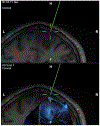Intraoperative Imaging for High-Grade Glioma Surgery
- PMID: 33223025
- PMCID: PMC7813557
- DOI: 10.1016/j.nec.2020.09.003
Intraoperative Imaging for High-Grade Glioma Surgery
Abstract
This article discusses intraoperative imaging techniques used during high-grade glioma surgery. Gliomas can be difficult to differentiate from surrounding tissue during surgery. Intraoperative imaging helps to alleviate problems encountered during glioma surgery, such as brain shift and residual tumor. There are a variety of modalities available all of which aim to give the surgeon more information, address brain shift, identify residual tumor, and increase the extent of surgical resection. The article starts with a brief introduction followed by a review of with the latest advances in intraoperative ultrasound, intraoperative MRI, and intraoperative computed tomography.
Keywords: Glioblastoma; High-grade glioma; Intraoperative CT; Intraoperative MRI; Intraoperative imaging.
Copyright © 2020 Elsevier Inc. All rights reserved.
Conflict of interest statement
Disclosure The authors have nothing to disclose.
Figures




Similar articles
-
Intraoperative computed tomography, navigated ultrasound, 5-amino-levulinic acid fluorescence and neuromonitoring in brain tumor surgery: overtreatment or useful tool combination?J Neurosurg Sci. 2024 Feb;68(1):31-43. doi: 10.23736/S0390-5616.19.04735-0. Epub 2019 Jul 11. J Neurosurg Sci. 2024. PMID: 31298506
-
Surgical benefits of combined awake craniotomy and intraoperative magnetic resonance imaging for gliomas associated with eloquent areas.J Neurosurg. 2017 Oct;127(4):790-797. doi: 10.3171/2016.9.JNS16152. Epub 2017 Jan 6. J Neurosurg. 2017. PMID: 28059650
-
Optimizing the Extent of Resection and Minimizing the Morbidity in Insular High-Grade Glioma Surgery by High-Field Intraoperative MRI Guidance.Turk Neurosurg. 2017;27(5):696-706. doi: 10.5137/1019-5149.JTN.18346-16.1. Turk Neurosurg. 2017. PMID: 27651342
-
Surgical approaches for the gliomas.Handb Clin Neurol. 2016;134:51-69. doi: 10.1016/B978-0-12-802997-8.00004-9. Handb Clin Neurol. 2016. PMID: 26948348 Review.
-
Combining Functional Studies with Intraoperative MRI in Glioma Surgery.Neurosurg Clin N Am. 2017 Oct;28(4):487-497. doi: 10.1016/j.nec.2017.05.004. Epub 2017 Jun 29. Neurosurg Clin N Am. 2017. PMID: 28917278 Review.
Cited by
-
Side-firing intraoperative ultrasound applied to resection of pituitary macroadenomas and giant adenomas: A single-center retrospective case-control study.Front Oncol. 2022 Nov 30;12:1043697. doi: 10.3389/fonc.2022.1043697. eCollection 2022. Front Oncol. 2022. PMID: 36531061 Free PMC article.
-
Intraoperative Imaging and Optical Visualization Techniques for Brain Tumor Resection: A Narrative Review.Cancers (Basel). 2023 Oct 9;15(19):4890. doi: 10.3390/cancers15194890. Cancers (Basel). 2023. PMID: 37835584 Free PMC article. Review.
-
Is intraoperative ultrasound more efficient than magnetic resonance in neurosurgical oncology? An exploratory cost-effectiveness analysis.Front Oncol. 2022 Oct 28;12:1016264. doi: 10.3389/fonc.2022.1016264. eCollection 2022. Front Oncol. 2022. PMID: 36387079 Free PMC article.
-
Maximal Safe Resection in Glioblastoma Surgery: A Systematic Review of Advanced Intraoperative Image-Guided Techniques.Brain Sci. 2023 Jan 28;13(2):216. doi: 10.3390/brainsci13020216. Brain Sci. 2023. PMID: 36831759 Free PMC article. Review.
-
Novel rapid intraoperative qualitative tumor detection by a residual convolutional neural network using label-free stimulated Raman scattering microscopy.Acta Neuropathol Commun. 2022 Aug 6;10(1):109. doi: 10.1186/s40478-022-01411-x. Acta Neuropathol Commun. 2022. PMID: 35933416 Free PMC article.
References
-
- Bernadette Henrichs., Walsh Robert P. Intraoperative MRI for neurosurgical and general surgical interventions. Curr Opin Anaesthesiol 2014;27(4):448–52. - PubMed
-
- Thomas Ginat Daniel, Brooke Swearingen, William Curry., et al. 3 Tesla intraoperative MRI for brain tumor surgery. J Magn Reson Imaging 2014;39(6): 1357–65. - PubMed
-
- Peter Black., Jolesz Ferenc A., Khalid Medani. From vision to reality: the origins of intraoperative MR imaging. Acta Neurochir Supp1 2011;109:3–7. - PubMed
Publication types
MeSH terms
Grants and funding
LinkOut - more resources
Full Text Sources
Other Literature Sources
Medical

